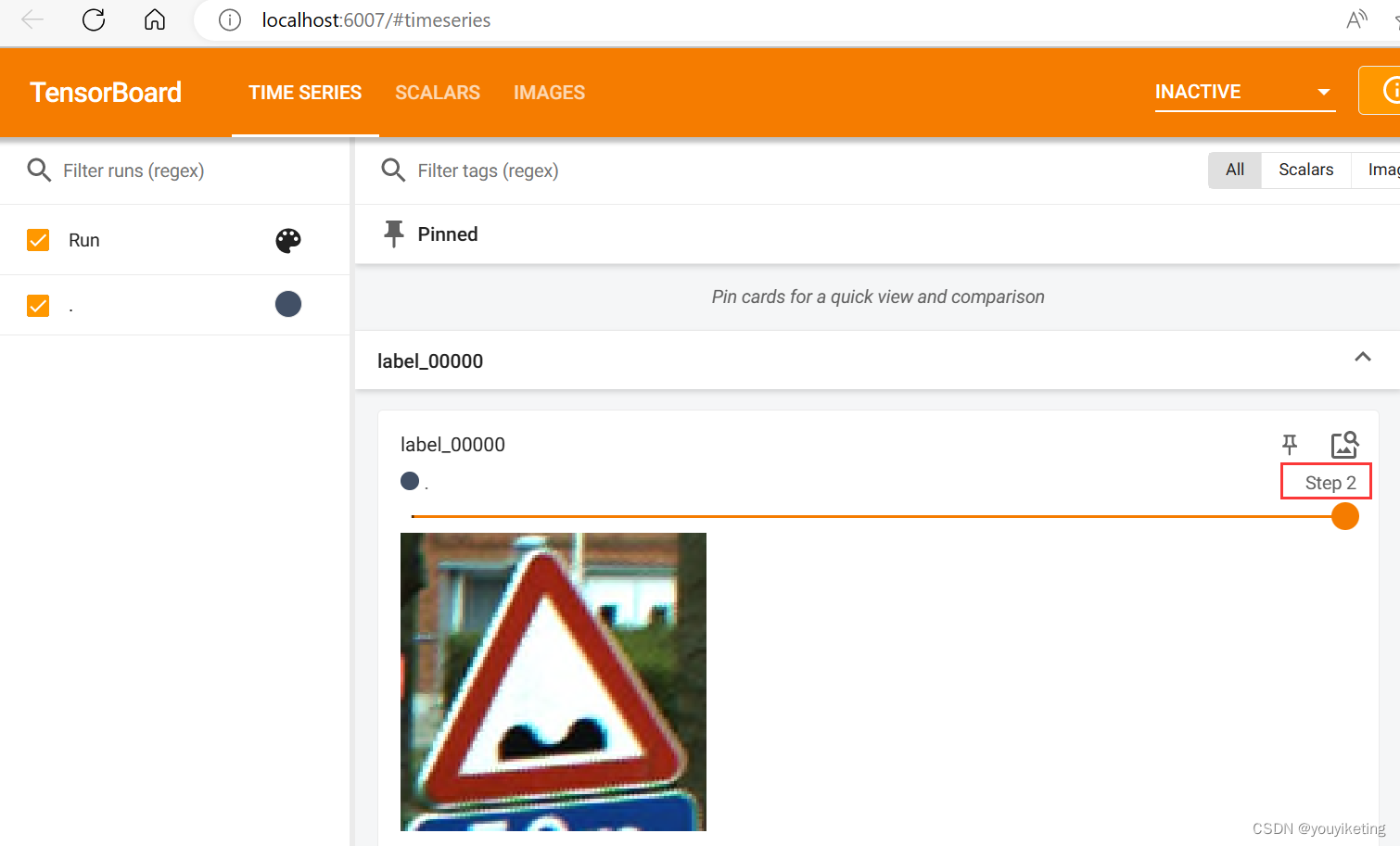目录
Tensorboard在训练模型时很有用,可以看训练过程中loss的变化。之前用于Tensorflow框架,自Pytorch1.1之后,Pytorch也加了这个功能。
安装tensorboard:
pip install tensorboard
1. SummaryWriter 类
SummaryWriter类可以在指定文件夹生成一个事件文件,这个事件文件可以对TensorBoard解析。
PS:在pycharm中可以通过 ”按住ctrl建+左击“ 查看类/函数
参数:
class SummaryWriter(object):
"""Writes entries directly to event files in the log_dir to be
consumed by TensorBoard.
The `SummaryWriter` class provides a high-level API to create an event file
in a given directory and add summaries and events to it. The class updates the
file contents asynchronously. This allows a training program to call methods
to add data to the file directly from the training loop, without slowing down
training.
"""
def __init__(
self,
log_dir=None,
comment="",
purge_step=None,
max_queue=10,
flush_secs=120,
filename_suffix="",
):
"""Creates a `SummaryWriter` that will write out events and summaries
to the event file.
Args:
log_dir (str): Save directory location. Default is
runs/**CURRENT_DATETIME_HOSTNAME**, which changes after each run.
Use hierarchical folder structure to compare
between runs easily. e.g. pass in 'runs/exp1', 'runs/exp2', etc.
for each new experiment to compare across them.
comment (str): Comment log_dir suffix appended to the default
``log_dir``. If ``log_dir`` is assigned, this argument has no effect.
purge_step (int):
When logging crashes at step :math:`T+X` and restarts at step :math:`T`,
any events whose global_step larger or equal to :math:`T` will be
purged and hidden from TensorBoard.
Note that crashed and resumed experiments should have the same ``log_dir``.
max_queue (int): Size of the queue for pending events and
summaries before one of the 'add' calls forces a flush to disk.
Default is ten items.
flush_secs (int): How often, in seconds, to flush the
pending events and summaries to disk. Default is every two minutes.
filename_suffix (str): Suffix added to all event filenames in
the log_dir directory. More details on filename construction in
tensorboard.summary.writer.event_file_writer.EventFileWriter.
示例:
Examples::
from torch.utils.tensorboard import SummaryWriter
# create a summary writer with automatically generated folder name.
writer = SummaryWriter()
# folder location: runs/May04_22-14-54_s-MacBook-Pro.local/
# create a summary writer using the specified folder name.
writer = SummaryWriter("my_experiment")
# folder location: my_experiment
# create a summary writer with comment appended.
writer = SummaryWriter(comment="LR_0.1_BATCH_16")
# folder location: runs/May04_22-14-54_s-MacBook-Pro.localLR_0.1_BATCH_16/
"""2. add_scalar()
可视化函数
参数:
def add_scalar(
self,
tag,
scalar_value,
global_step=None,
walltime=None,
new_style=False,
double_precision=False,
):
"""Add scalar data to summary.
Args:
tag (str): Data identifier
scalar_value (float or string/blobname): Value to save--y轴
global_step (int): Global step value to record--x轴
walltime (float): Optional override default walltime (time.time())
with seconds after epoch of event
new_style (boolean): Whether to use new style (tensor field) or old
style (simple_value field). New style could lead to faster data loading.示例:
Examples::
from torch.utils.tensorboard import SummaryWriter
writer = SummaryWriter()
x = range(100)
for i in x:
writer.add_scalar('y=2x', i * 2, i)
writer.close()
Expected result:
.. image:: _static/img/tensorboard/add_scalar.png
:scale: 50 %
"""实战
from torch.utils.tensorboard import SummaryWriter
# 实例化
writer = SummaryWriter("logs")
# "y=3x" logs
for i in range(100):
writer.add_scalar("y=3x", 3*i, i)
writer.close()运行,项目文件下多出一个logs文件夹,其下是Tensorboad的事件文件.

打开这个事件文件,terminal命令行窗口输入以下指令,从6007端口打开事件文件(其中logs为事件文件所在的路径,这里是相对路径)
tensorboard --logdir=logs --port=6007

点击链接,查看绘制结果

3. add_image()
PS:该函数只支持三种图像数据类型:torch.Tensor, numpy.ndarray, or string/blobname
参数:
def add_image(
self, tag, img_tensor, global_step=None, walltime=None, dataformats="CHW"
):
"""Add image data to summary.
Note that this requires the ``pillow`` package.
Args:
tag (str): Data identifier
img_tensor (torch.Tensor, numpy.ndarray, or string/blobname): Image data
--图像数据集类型
global_step (int): Global step value to record
walltime (float): Optional override default walltime (time.time())
seconds after epoch of event
dataformats (str): Image data format specification of the form
CHW, HWC, HW, WH, etc.
Shape:
img_tensor: Default is :math:`(3, H, W)`. You can use ``torchvision.utils.make_grid()`` to
convert a batch of tensor into 3xHxW format or call ``add_images`` and let us do the job.
Tensor with :math:`(1, H, W)`, :math:`(H, W)`, :math:`(H, W, 3)` is also suitable as long as
corresponding ``dataformats`` argument is passed, e.g. ``CHW``, ``HWC``, ``HW``.
示例:
Examples::
from torch.utils.tensorboard import SummaryWriter
import numpy as np
img = np.zeros((3, 100, 100))
img[0] = np.arange(0, 10000).reshape(100, 100) / 10000
img[1] = 1 - np.arange(0, 10000).reshape(100, 100) / 10000
img_HWC = np.zeros((100, 100, 3))
img_HWC[:, :, 0] = np.arange(0, 10000).reshape(100, 100) / 10000
img_HWC[:, :, 1] = 1 - np.arange(0, 10000).reshape(100, 100) / 10000
writer = SummaryWriter()
writer.add_image('my_image', img, 0)
# If you have non-default dimension setting, set the dataformats argument.
writer.add_image('my_image_HWC', img_HWC, 0, dataformats='HWC')
writer.close()
Expected result:
.. image:: _static/img/tensorboard/add_image.png
:scale: 50 %
"""实战:
from torch.utils.tensorboard import SummaryWriter
import numpy as np
from PIL import Image
# 实例化
writer = SummaryWriter("logs")
# "label_00000"
image_path_1 = R"C:\Users\L\Desktop\deeplearning\BelgiumTSC\Training\00000\01153_00000.ppm"
img_PIL_1 = Image.open(image_path_1)
img_array_1 = np.array(img_PIL_1)
print(type(img_array_1))
print(img_array_1.shape)
writer.add_image("label_00000", img_array_1, 1, dataformats='HWC')
image_path_2 = R"C:\Users\L\Desktop\deeplearning\BelgiumTSC\Training\00000\01153_00001.ppm"
img_PIL_2 = Image.open(image_path_2)
img_array_2 = np.array(img_PIL_2)
print(type(img_array_2))
print(img_array_2.shape)
writer.add_image("label_00000", img_array_2, 2, dataformats='HWC')
writer.close()结果 :step1、step2的2个图片在一个窗口
























 2575
2575











 被折叠的 条评论
为什么被折叠?
被折叠的 条评论
为什么被折叠?








